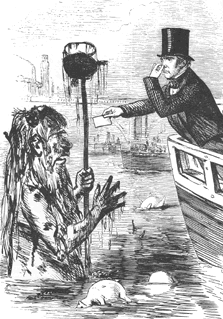Disease accounted for many deaths in industrial cities during the Industrial Revolution. With a chronic lack of hygiene, little knowledge of sanitary care and no knowledge as to what caused diseases (let alone cure them), diseases such as cholera, typhoid and typhus could be devastating. As the cities became more populated, so the problem got worse.

A filthy “Father Thames”
Cholera was a greatly feared disease. Caused by contaminated water, it could spread with speed and with devastating consequences. Not for nothing did the disease get the nick-name “King Cholera“. Industrial Britain was hit by an outbreak of cholera in 1831-32, 1848-49, 1854 and 1867. The cause was simple – sewage was being allowed to come into contact with drinking water and contaminating it. As many people used river water as their source of drinking water, the disease spread with ease.
An attack of cholera is sudden and painful – though not necessarily fatal. In London it is thought 7000 people died of the disease in the 1831-32 outbreak which represented a 50% death rate of those who caught it. 15,000 people died in London in the 1848-49 outbreak. The disease usually affected those in a city’s poorer areas, though the rich did not escape this disease.
Smallpox made a major re-occurrence in industrial cities even after Edward Jenner’s vaccine. The reason was simple. Very many in the industrial cities were ignorant of the fact that Jenner had developed a vaccine. As Britain continued on its road to a population mostly centred in cities and the agricultural regions became less populated, traditional old wives tales and developments linked to them (such as coxpox, milk maids, Jenner etc) became less well known. Also the overcrowded tenements of the cities were a perfect breeding ground for smallpox.
Typhoid and typhus were as feared as cholera. Both were also fairly common in the Industrial Revolution. Typhoid was caused by infected water whereas typhus was carried by lice. Both were found in abundance in industrial cities.
The greatest killer in the cities was tuberculosis (TB). The disease caused a wasting of the body with the lungs being attacked. The lungs attempt to defend themselves by producing what are called tubercles. The disease causes these tubercles to become yellow and spongy and coughing fits causes them to be spat out by the sufferer.
TB affected those who had been poorly fed and were under nourished. It also affected those who lived in dirty and damp homes. TB can be spread by a person breathing in the exhaled sputum of someone who already has the disease. In the overcrowded tenements of the industrial cities, one infected person could spread the disease very easily.
Though accurate records are difficult to acquire, it is believed that TB killed one-third of all those who died in Britain between 1800 and 1850.
Microbes were only discovered in 1864 by Louis Pasteur. Until that time all manner of theories were put forward as to what caused diseases. A common belief – and one that dated back to Medieval England – was that disease was spread by bad smells and invisible poisonous clouds (miasmas). Industrial cities were certainly plagued by poor smells from sewage, industrial pollutants etc. The majority of deaths were in the industrial cities. Therefore, doctors concluded, the two went together: death and bad smells/gasses.
Such beliefs caused serious problems. In Croydon, typhoid swept through the town in 1852. The local Board of Health went about looking for a smell that caused the disease but found nothing. In fact, sewage had seeped into the town’s water supplies and contaminated the water. It did not occur to the health officials that the water could be the cause of the disease as medical wisdom of the time dictated another cause.
Even a great reformer like Edwin Chadwick was convinced that disease was carried in the atmosphere which had been poisoned by foul smells. In 1849, he persuaded the authorities in London to clean up the sewers in their districts. This, so Chadwick believed, would get rid of the bad smells and therefore disease. Each week an estimated 6000 cubic yards of filth was swept into the River Thames – London’s main source of water. Cholera was given a chance to spread and 30,000 Londoners got the disease in 1849 with 15,000 dying as a result.